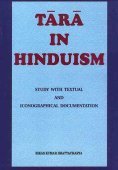Mulamantra, Mūlamantra, Mula-mantra, Mulamamtra: 9 definitions
Introduction:
Mulamantra means something in Buddhism, Pali, Hinduism, Sanskrit. If you want to know the exact meaning, history, etymology or English translation of this term then check out the descriptions on this page. Add your comment or reference to a book if you want to contribute to this summary article.
Images (photo gallery)
In Hinduism
Purana and Itihasa (epic history)
Source: archive.org: Shiva Purana - English TranslationMūlamantra (मूलमन्त्र) \is the name of a Mantra associated with waring Rudrākṣa beads, according to the Śivapurāṇa 1.25, while explaining the greatness of Rudrākṣa:—“[...] with five mantras—Sadyojāta etc. three, five or seven garlands shall be worn. Or all beads shall be worn with the Mūlamantra”.

The Purana (पुराण, purāṇas) refers to Sanskrit literature preserving ancient India’s vast cultural history, including historical legends, religious ceremonies, various arts and sciences. The eighteen mahapuranas total over 400,000 shlokas (metrical couplets) and date to at least several centuries BCE.
Vaishnavism (Vaishava dharma)
Source: Pure Bhakti: Arcana-dipika - 3rd EditionMūlamantra (मूलमन्त्र) refers to:—Root mantra; the mantra that identifies the deity one is worshipping. (cf. Glossary page from Arcana-dīpikā).

Vaishnava (वैष्णव, vaiṣṇava) or vaishnavism (vaiṣṇavism) represents a tradition of Hinduism worshipping Vishnu as the supreme Lord. Similar to the Shaktism and Shaivism traditions, Vaishnavism also developed as an individual movement, famous for its exposition of the dashavatara (‘ten avatars of Vishnu’).
Shaivism (Shaiva philosophy)
Source: SOAS University of London: Protective Rites in the Netra TantraMūlamantra (मूलमन्त्र) refers to the “root mantra”, according to the Netratantra of Kṣemarāja: a Śaiva text from the 9th century in which Śiva (Bhairava) teaches Pārvatī topics such as metaphysics, cosmology, and soteriology.—Accordingly, [verse 10.39-45]—“Now I shall explain the protection of the king [with the mantra]. [The Mantrin] should write the name [of the king] enveloped in the middle of the mantra. Above this, he should worship Bhairava, Deva and Amṛteśa, O Beautiful. The Devīs and Dūtis are joined with him at the end [of the mantra] on the petals. Thus, the servants [become] bound to the root Mantra (mūlamantra). [...]”.

Shaiva (शैव, śaiva) or Shaivism (śaivism) represents a tradition of Hinduism worshiping Shiva as the supreme being. Closely related to Shaktism, Shaiva literature includes a range of scriptures, including Tantras, while the root of this tradition may be traced back to the ancient Vedas.
In Buddhism
Mahayana (major branch of Buddhism)
Source: De Gruyter: A Buddhist Ritual Manual on AgricultureMūlamantra (मूलमन्त्र) refers to the “root mantra”, according to the Vajratuṇḍasamayakalparāja, an ancient Buddhist ritual manual on agriculture from the 5th-century (or earlier), containing various instructions for the Sangha to provide agriculture-related services to laypeople including rainmaking, weather control and prescriptions for the use of specially empowered pesticides to eliminate crop damage.—The Vajratuṇḍa-samayakalparāja consists of six chapters, e.g., (4) mūlamantravidhisopacāra—“The Manual of the Root Mantra with the Offering.

Mahayana (महायान, mahāyāna) is a major branch of Buddhism focusing on the path of a Bodhisattva (spiritual aspirants/ enlightened beings). Extant literature is vast and primarely composed in the Sanskrit language. There are many sūtras of which some of the earliest are the various Prajñāpāramitā sūtras.
Languages of India and abroad
Sanskrit dictionary
Source: DDSA: The practical Sanskrit-English dictionaryMūlamantra (मूलमन्त्र).—
1) a principal or primary text (such as āgama); जुहुयान्मूलमन्त्रेण पुंसूक्तेनाथवा बुधः (juhuyānmūlamantreṇa puṃsūktenāthavā budhaḥ) A. Rām.4.4.31.
2) a spell.
Derivable forms: mūlamantraḥ (मूलमन्त्रः).
Mūlamantra is a Sanskrit compound consisting of the terms mūla and mantra (मन्त्र).
Source: Cologne Digital Sanskrit Dictionaries: Monier-Williams Sanskrit-English Dictionary1) Mūlamantra (मूलमन्त्र):—[=mūla-mantra] [from mūla > mūl] m. a principal or primary or fundamental text, [Bhāgavata-purāṇa; Hemādri’s Caturvarga-cintāmaṇi] etc.
2) [v.s. ...] a spell, [Kādambarī]
[Sanskrit to German]
Sanskrit, also spelled संस्कृतम् (saṃskṛtam), is an ancient language of India commonly seen as the grandmother of the Indo-European language family (even English!). Closely allied with Prakrit and Pali, Sanskrit is more exhaustive in both grammar and terms and has the most extensive collection of literature in the world, greatly surpassing its sister-languages Greek and Latin.
Kannada-English dictionary
Source: Alar: Kannada-English corpusMūlamaṃtra (ಮೂಲಮಂತ್ರ):—
1) [noun] '''ಓಂ [om]'' the sacred syllable which is supposed to be the base of all hymns.'2) [noun] the main hymn.
3) [noun] the basic, fundamental or main aim (of a person, movement, nation, etc.).
Kannada is a Dravidian language (as opposed to the Indo-European language family) mainly spoken in the southwestern region of India.
See also (Relevant definitions)
Partial matches: Mantra, Mula.
Starts with: Mulamantramaya, Mulamantrarthasara, Mulamantrasara, Mulamantravidhi.
Full-text (+23): Mulamantrasara, Mulamantramaya, Angamantra, Mulamantrarthasara, Mulavidya, Shat-ankamantiram, Dipa, Vastra, Shankha, Camara, Dhupa, Pushpa, Pankha, Vishasamhara, Tatsthita, Asesa, Sarpoccatanayantra, Shishyacaitanya, Nivrittashesha, Samana.
Relevant text
Search found 20 books and stories containing Mulamantra, Mula-mantra, Mūla-mantra, Mulamamtra, Mūlamaṃtra, Mūlamantra; (plurals include: Mulamantras, mantras, Mulamamtras, Mūlamaṃtras, Mūlamantras). You can also click to the full overview containing English textual excerpts. Below are direct links for the most relevant articles:
The Linga Purana (by J. L. Shastri)
Chapter 24 - The mode of worship of Śiva (Continued) < [Section 2 - Pūrvabhāga]
Chapter 22 - The consecration of the Tattvas < [Section 2 - Pūrvabhāga]
Chapter 23 - The mode of worship of Siva < [Section 2 - Pūrvabhāga]
The Agni Purana (by N. Gangadharan)
Chapter 311 - The location of the basic mantras of Tvaritā and Her worship
Chapter 22 - Procedure for bathing prior to a religious rite
The Skanda Purana (by G. V. Tagare)
Chapter 2 - The Application of Tripuṇḍra < [Section 5 - Mārgaśīrṣa-māhātmya]
Chapter 26 - Eligibility for Kriyā-Yoga etc. < [Section 9 - Vāsudeva-māhātmya]
Chapter 30 - The Greatness of Pañcatīrtha < [Section 2 - Puruṣottama-kṣetra-māhātmya]
Chaitanya Bhagavata (by Bhumipati Dāsa)
Verse 2.16.141 < [Chapter 16 - The Lord’s Acceptance of Śuklāmbara’s Rice]
Verse 1.15.4 < [Chapter 15 - Marriage with Śrī Viṣṇupriyā]
Expiatory Rites in Keralite Tantra (by T. S. Syamkumar)
2. Expiatory Rites in Tantrasamuccaya < [Chapter 3 - Expiatory Rites in Kerala Tantric Ritual Manuals]
1.7. Expiatory Rites in Ājitāgama and Dīptāgama < [Chapter 2 - Expiatory Rites in Āgamic Literature]
The Devi Bhagavata Purana (by Swami Vijñanananda)
Related products

